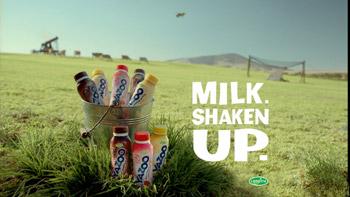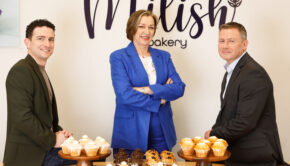Bright young things

Just over a fifth of the Irish population is under the age of 14, and this age group is exerting an increasing influence over household purchasing decisions
11 March 2009
At a glance: YOUNG CONSUMERS
- Birth rates have been steadily increasing in the Republic since 1994 and just over a fifth of the population is under the age of 14
- The Laughing Cow has the number one position in the Irish processed cheese portions market with a 70% value share (Nielsen MAT Jan 25/09)
- Yazoo, the UK’s favourite milkshake brand, is to unveil a new heavyweight £3.5m TV and outdoor advertising campaign
- Last year Yazoo grew to an £85m brand and achieved a 42% volume share in the impulse channel (AC Nielsen 2008)
- Ireland’s hot snacking market is currently growing at 21% (Kepak Convenience Foods, Ex Factory Data), with household penetration up by 42% (Millward Brown IMS, Usage & Attitudes Survey, 2008)
- Panini has made Ireland its new testing ground for trading cards and ring tones; according to a November 2008 International Communications Report from Ofcom, Ireland uses mobile phones more than anywhere else in the world
- Each person spends an average of 179 minutes on their handset every month and sends over 150 texts, compared with just 81 in the UK
Young consumers, between the ages of four and 16 exert a large influence over the purchasing decisions of their families. A 2008 report by Mintel states that the increasing influence these children and teenagers have over home mealtimes makes them a demographic worth pursuing. At the same time, due to the alarming increase in obesity among young people in recent years, pressures from the government and other groups has made many food and snack manufacturers wary of how they market their products. In spite of this, new products aimed at teens and kids abound in the snack and food aisles, and all evidence shows that this will continue to be the case.
Due to increasing birth rates since 1994, just over a fifth of the Irish population is under 14. Panini recently declared Ireland its testing ground for the next generation of trading cards and ring tones, due to its youthful population and the Irish love affair with the mobile phone. According to a November 2008 International Communications Report from Ofcom, Ireland uses mobile phones more than anywhere else in the world.
Milk-shaking the market up
Yazoo, the UK’s favourite milkshake brand, is to unveil a new heavyweight £3.5m TV and outdoor advertising campaign. The 30 second TV ad, which first breaks in Ireland on 1 March and forms part of the brand’s on-going mission to drive growth in the UK flavoured milk category, will run until 30 March. A print version of the ad will then appear on buses across the UK, running in parallel with a nation wide sampling campaign and on pack promotions.
Working with WFCA Integrated, Campina repositioned the Yazoo brand in 2008 to appeal to an adult audience alongside its heartland of mums and kids. The first phase was completed in November last year with the introduction of modern packaging and a new recipe with real fruit juice and no artificial sweeteners. The second phase builds on the “Milk Shaken Up” campaign and takes the idea on TV for the first time. The pure and clean nature of the countryside depicted in the ad complements Yazoo’s new healthier recipe credentials and the unorthodox behaviour of the Yazoo cow highlights the brand’s light-hearted qualities.
Marielle de Jong, marketing director for FrieslandCampina brands in the UK, comments: “The new TV advert supports our core brand messaging that Yazoo offers all the goodness of milk, is low in fat, and contains natural flavours and real fruit juice. We believe that this new ad, as well as the other components of our new campaign, will captivate consumers and provide retailers with another great opportunity to capitalise on the brand’s popularity.
“Last year Yazoo grew to an £85m brand and achieved a 42% volume share in the impulse channel (AC Nielsen 2008). The flavoured milk category is one of the few drivers of growth in the otherwise static soft drinks market and our continued focus on quality and commitment to well placed marketing campaigns has strongly contributed to this success.”
Making cooking easy
Driven by Kepak Convenience Foods (KCF), the Republic of Ireland’s hot snacking market is currently growing at 21% (Kepak Convenience Foods, Ex Factory Data), with household penetration up by 42% (Millward Brown IMS, Usage & Attitudes Survey, 2008).
Hot snacking products enable children and young teens to prepare food for themselves at home, with parents happy in the knowledge that hot snacks can be cooked safely and easily, according to market-leading KCF.
“The fact that hot snacks such as Rustlers can be cooked in the microwave is a source of comfort for parents who want to give teenage children more independence at home, without allowing them the full run of the kitchen and the dangers that presents,” says John Armstrong, Kepak Convenience Foods’ marketing director.
With the decline in families eating together, particularly during the week, and more parents out at work when teenagers choose to eat, many teenagers are turning to hot snacking products to fill the hunger gap.
“Teenagers enjoy the quick, convenient nature of hot snacking products and for many of them it is the first snack or meal they cook for themselves at home. The thought of not having to wash up afterwards also appeals,” adds John Armstrong.
Kepak’s commitment to quality reassurance and to continually improve the goodness of its products has also struck a chord with parents, for whom product goodness is high on the agenda.
In addition, as part of a recent brand relaunch, KCF has improved Rustlers’ taste appeal by introducing a stronger, flame grilled charcoal flavour, due to an upgraded cooking process.
KCF will be backing the Rustlers brand in 2009 with a new TV advertisement, press advertising, sampling and close links with the growing video gaming industry.
Flavoursome fun
Mini Babybel is an instantly recognisable brand with its distinctive red waxy jacket. Its novel ‘zipper’ opening makes it a fun cheese to be enjoyed at any time. Mini Babybel has all the natural flavour and nutritional goodness of real cheese making it a perfect lunchbox snack solution. Mini Babybel is available in Original, Light, Cheddar and Emmental varieties and is sold in nets of six. Mini Babybel is supported by ongoing TV advertising as well as strong trade promotions.
Bovine comedy
The Laughing Cow cheese portions are convenient and fun, with a smooth, creamy taste. The cheese is also a natural source of calcium, which is good news for teeth and bones. The Laughing Cow has the number one position in the Irish processed cheese portions market with a 70% value share (Nielsen MAT Jan 25/09). The brand has ongoing support above the line with TV advertising, as well as ongoing trade promotions.
Gaining young attentions through promotions
Promotions can be an effective way of engaging young consumers in products and stores. Get it right, and a well thought out one can help sustain the interest of this influential consumer group and generate repeat footfall into a store. David Ringer is general manager UK and Ireland for The Continuity Company (TCC), a provider of retail marketing programmes globally. Here, he looks at the factors which should be considered for a promotion to yield optimum results.
Ethical approach
“Care must be taken to ensure the promotion is suitable, but also that it is ethically applied and won’t induce undue pressure on parents, especially in the current economic climate.
“Our research into collectable programmes targeted children aged 7-10 and mothers of children aged 7-10. When asked if they would take part in promotions, 57% of mothers stated they would take part in promotions offering a free gift aimed at children.”
Shifting trends favour Nintendo DS
“Traditional staples of the toy box such as Action Man and Barbie have given way to Nintendo DS, with 61% of children stating that they would participate in promotions based around the console.
“TV characters achieved 52%, movie characters achieved 30% and football related collectables still are very appealing with 39% of both girls and boys stating they would actively participate.”
Sophisticated tastes
“This clearly demonstrates the power of popular culture amongst juvenile audiences and that with an appealing theme and licensed property, sales promotions can be very powerful. Children remain a strong target market, but marketing programmes need to take on board that tastes are more sophisticated and adapt accordingly if they are to successfully influence shopper behaviour. Furthermore promoters have a responsibility to stimulate positive ethical behavioural change such as diet and exercise.”
Ireland to become ‘testing ground’ for new trading cards
Ireland is to become the testing ground for the next generation of trading cards. Panini, the organisation behind the popular football players stickers collection, said it chose Ireland as its trial base because of its youthful population with a strong attachment to their mobile phones.
Collectible cards have also been brought online. Children will be able to buy Mutone cards in shops, register them on the internet, and then play against other collectors on line and exchange points for free ringtones and other online bonus extras.
Said Mark Warsop, Panini’s marketing director: “Ireland was the perfect launch pad for the Mutones. There are few places in the world with such a young, tech-savvy population with such a good sense of humour.”
Panini said according to a November 2008 International Communications Report from Ofcom, Ireland uses mobile phones more than anywhere else in the world. Each person spends an average of 179 minutes on their handset every month and sends over 150 texts, compared with just 81 in the UK. Monthly spending by the Irish on their phone bills is second only to Switzerland among the major European markets, according to 2005 figures from ComReg.



 Print
Print






Fans 0
Followers